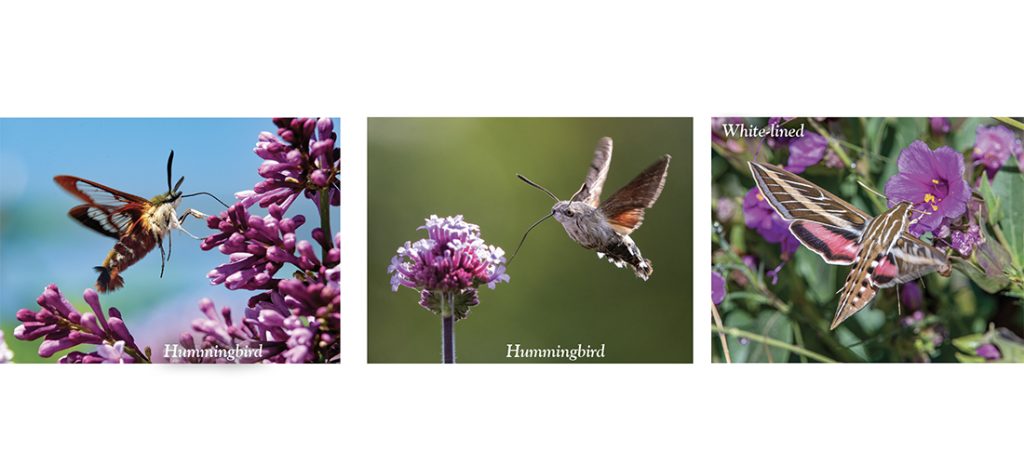Birdwatch

A Case of Mistaken Identity
It’s not a baby hummingbird at all
By Susan Campbell
I am waiting, just waiting, for the first call to come in from someone who has seen a “baby hummingbird.” Although this is the time when young ruby-throateds are appearing at feeders and flowers across the state, the first report of the year is usually from a very puzzled observer. Not only has he or she spotted a very small hummer, but it looks to be of another species: The color pattern is very different. So, what is it?
The answer is always the same: It’s not a hummingbird at all, but a moth. Indeed, these insects hover to feed from brightly colored flowers and appear to have a long bill, but they are insects. The giveaway is the long antennae but, on such a small, fast flier, the antennae and three pairs of legs are easily overlooked. The odd behavior and body coloration are what grab one’s attention. The confusion is so common that many bird identification guides depict these moths on the same page alongside the details for ruby-throated hummingbirds.
Here in the North Carolina Piedmont and Sandhills, we have at least three kinds of so-called hummingbird moths, all of which are in the Sphingidae family. Two are “clearwing” moths: the hummingbird clearwing and the hummingbird hawk-moth. We have white-lined sphinx moths in late summer as well. They are all exclusively nectivorous, feeding from many of the same blooms frequented by hummingbirds. With their long proboscis, they can reach down into the tubular flowers of impatiens, fuchsias and assorted salvias, to name a few.
The clearwings are named for the transparent midsection of their wings. The rest of the body is frequently reddish but may be a shade of blue. They are active during the day, flitting from plant to plant in search of a sweet meal. Typically clearwings are not intimidated by human activity, probably because four-legged mammals do not prey on moths in our area. That means one can usually approach these beautiful creatures very closely. If you have the patience as well as a fast shutter speed, you may be able to get some excellent shots of these very photogenic insects.
Sphinx moths are large, striking and interesting. Unlike the clearwings, they are creatures of the night. They can be abundant at the same flowers hummingbirds use during the day, but most people are totally unaware of their existence given their nocturnal habits. It’s the caterpillar of this group that is more familiar. Typically called a hornworm (given the yellowy head projections), they are voracious pests on a variety of plants such as tomatoes, peppers, eggplant and tobacco. However, not only are the adult sphinx moths eaten by bats and small owls but, as caterpillars, hornworms are sought out by tiny braconid wasps. The eggs of the wasp develop under the skin of the caterpillar. Once they pupate, they attach themselves externally and are mistakenly thought to be the eggs of yet more caterpillars. When the caterpillars are in this state, they have very little time to live and are no longer a threat to the plants.
Keep your eyes peeled around the yard this summer. You may be lucky enough to spot one of these “baby hummers” hovering among the blooms. OH
Susan Campbell would love to receive your wildlife sightings and photographs at susan@ncaves.com.
